Building of the Month - January 2017


The Iveagh Play Centre (1912-5) in Bull Alley Street, Dublin, was an innovate school intended to complete the philanthropic vision of Edward Cecil Guinness (1847-1927), first Earl of Iveagh, scion of the enormously rich and influential brewing family. It, and the larger scheme of which it was part, provides one of the most notable examples of the power and reach of private philanthropy in poverty-riven late Victorian and early Edwardian Dublin. Informed by the affordable housing initiatives pioneered by social reformers such as Octavia Hill (1838-1912) and George Peabody (1795-1869) in the notorious “Rookeries” and “Stews” of Victorian London, Iveagh lent his considerable finances and political clout to the endeavour. Consequently, in 1890 the Guinness Trust was simultaneously founded in Dublin and London ‘for the amelioration of the condition of the poorer of the working classes’ [1].
Iveagh’s vision for Dublin was to create a complex of housing and associated educational and health-improving facilities to replace some of the existing tenement slums in and around Saint Patrick’s Cathedral, a stone’s throw from the Guinness Brewery. Known collectively as the “Bull Alley Complex”, it consisted of affordable workmen’s housing in Patrick Street (1901) and Bride Street (1904); a workmen’s hostel called Iveagh House (1904-5); and the Iveagh Trust Public Baths (1905-6). Although somewhat removed, the Iveagh Markets (1902-6) designed by George Frederick Hicks (1870-1962) were also intended to form an integral part of the social – and moral – fabric of the enclave. The last piece put in place was the Iveagh Play Centre in Bull Alley Street.
As a building the Iveagh Play Centre was, according to the Irish Builder, ‘a novel one’ for Dublin and one which would be a welcome addition to the improvements already carried out by the Iveagh Trust in that part of the city [2]. In an echo of the philanthropic didactic, or paternalistic, impulse common in London’s East End in the late nineteenth century, the aim of the centre was ‘to provide education with amusement, so that the two wants of children can be catered for’ [3]. This resonated with Karl Friedrich Schinkel’s seminal credo on the function and role of museums: “First to delight, then to educate”. It also, in part, seems to borrow from the concept of “the people’s palace” in Walter Besant’s All Sorts of Conditions of Men (1882) – a scheme for a culture centre in London’s East End which the Toynbee Hall (1884), Whitechapel, and later the Mary Ward Settlement (1894), Bloomsbury, pioneered.
.jpg)
An illustration from The Irish Builder and Engineer (10th June 1911) showing the “Alternative Elevation” of the competition-winning design for what was then known as “The Guinness Trust Play Centre”. Note the different position of the doorcases in the proposal and the finished building. Also shown are the potbellied cherubs sitting on the window sills in the “pavilions”. These were the work of Albert George Power (1881-1945) of Geraldine Street, Dublin, but were later removed ‘as they offended the sensibilities of some of the respectable worshippers of Saint Patrick’s located directly across from the play centre. It was felt that such a display of nudity was not only unseemly in itself, but was particularly so opposite a house of God’ [4]
The best, most health-giving and picturesque site in the locale, one facing Saint Patrick’s Cathedral, was selected for the play centre. A limited competition was held to find a suitable architect. Of the four shortlisted architectural practices, the design by McDonnell and Reid, which has been described as ‘the most ambitious school building in the city…an exuberant and generously scaled essay in a Free Queen Anne idiom’, was chosen [5]. A Dublin firm, McDonnell and Reid had an interesting pedigree with Laurence Aloysius McDonnell (1867/8-1925) having the more traditional architectural education to Alexander William Douglas Reid’s Bachelor of Arts degree in Trinity College. Following his pupillage, McDonnell worked for Thomas Newenham Deane and Son and represented the practice in Oxford for two years. He then became principal assistant in the office of James Franklin Fuller (1835-1924) before setting up his own practice in 1886.
Before working with Reid, McDonnell appears to have enjoyed the patronage of some of the richest people in Ireland, not least John Hamilton Gordon (1847-1934), seventh Earl of Aberdeen and Lord Lieutenant of Ireland (fl. 1886; 1905-1915), and his wife Ishbel Maria Marjoribanks (1857-1939), a famed philanthropist and champion of women’s causes. Significantly for McDonnell’s career, Lady Aberdeen and her committee selected him to design an “Irish Industrial Village” for the Chicago World’s Fair (1892) and her husband later commissioned a design for a mansion in Scotland. It seems plausible that McDonnell and Reid’s appointment to design the Iveagh Play Centre was assisted by the fact that they had recently completed the construction of Lord Iveagh’s son’s house, Glenmaroon in Chapelizod, and so were seen as a capable and trusted team.
Work on construction began in October 1911 and the finished play centre, intended for children aged 3-14 living in the Patrick Street and Bride Street flats, opened in May 1915. The building was erected by McLaughlin and Harvey of Belfast and came in at a cost of £40,000 [6].
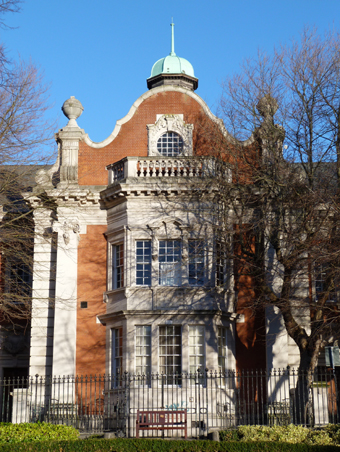
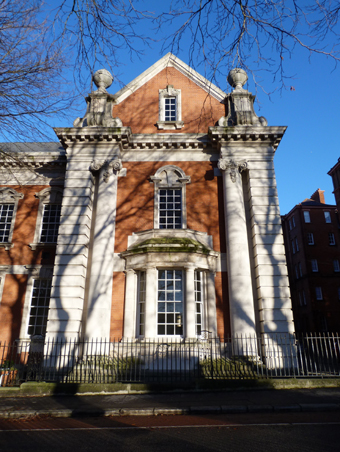
Occupying a prominent position fronting on to the new Saint Patrick’s Park (1901), McDonnell and Reid’s Iveagh Play Centre is a grandiose edifice strongly resembling a stately country house overlooking a formal garden. Faced with a vibrant Kingscourt red brick, the contrasting “white” limestone dressings produce an eye-catching two-tone palette in stark contrast to the sober Saint Patrick’s Cathedral on the opposite side of the park. The centrepiece, a cupola-topped projecting breakfront, features a curvilinear gable which can be interpreted as a nod to the so-called “Dutch Billys” once lining Dublin’s streets. Boldly-modelled doorcases decorated with acanthus-detailed pulvinated friezes, scroll pediments, garlands and swags, give access to the vestibules and classrooms on either side. The Bull Alley Streert front finishes in projecting “pavilions” with giant Ionic pillars framing colonnaded polygonal bay windows. A beautifully-carved modillioned cornice stretches across the full width of the façade and supports scroll-footed ball finials on the corners of each projection. Much like the earlier Tower Bridge (1886-94) in London, however, the conventional brick and stone finish and historical architectural references mask an innovative framework and an advertisement in the Irish Builder in October 1914 informs us that the English Expanded Metal Company supplied expanded metal for the fire-resistant reinforced concrete construction.
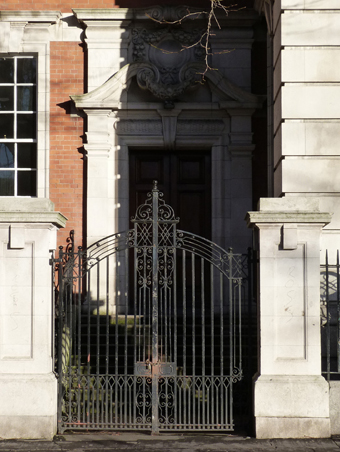
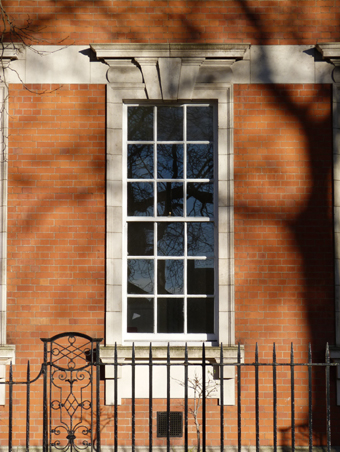
Planned on an “E”-shaped neo-Palladian-like footprint, the play centre was well-designed and equipped internally. In addition to a suite of bright and airy classrooms opening off a spinal corridor it boasted an assembly hall-cum-concert hall and a gymnasium.
.jpg)
A second illustration from the Irish Builder and Engineer showing the ground floor plan of the competition-winning design by McDonnell and Reid. On close inspection a number of significant variations between the proposed plan and the completed play centre become apparent: the breakfront is shown as three bays wide centring on a bowed, rather than a polygonal bay window; the wings, only four bays wide, are entered via slightly projecting porches; the end bays or “pavilions” lack their colonnaded bay windows; and the side elevations are five rather than seven bays wide
Open five evenings and one morning per week, the Iveagh Play Centre was a place where boys and girls were schooled in a wide range of subjects including basket weaving, dancing, gymnastics, needlework, painting and singing. The school quickly earned the affections of the children of the neighbourhood who nicknamed it the “Bayno” (beano or “free-for-all”) for the superior quality of its free buns and cocoa. Yet it was not just buns and cocoa that endeared the school to the children and from the outset it was successful as a venue for practical education and social interaction. The Iveagh Play Centre closed its doors in 1975, however, as the home of Liberties College the tradition of education and entertainment continues to this day for post-Leaving Certificate students.
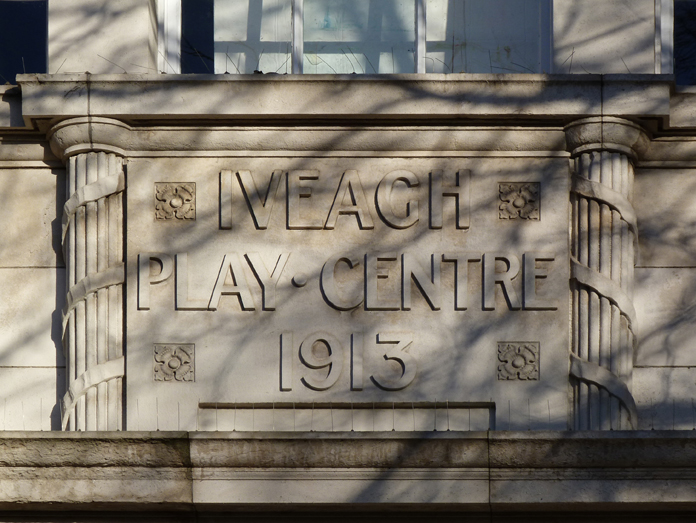
Dr. Niamh Marnham is a Senior Built Heritage Consultant at Ove Arup & Partners. She is a architectural historian and built heritage consultant who has worked with a broad range of clients, both private and public, on some of the most sensitive and significant buildings in Britain and Ireland. She has also lectured and written on aspects of architecture and conservation and is particularly interested in adaptive reuse, new design in historic places, landscapes of multiple pasts, and nineteenth- and twentieth-century architecture and cultural buildings. She is the author of the upcoming NIAH publication An Introduction to the Architectural Heritage of Dublin South City (2017)
1 Aalen, F.H.A., The Iveagh Trust: the first hundred years 1890-1990 (Dublin: Iveagh Trust, 1990), 14
2 Irish Builder 27th May 1911, 352
3 Irish Builder 8th May 1915, 209
4 Breathnach-Lynch, Sighle, “A Dublin Sculptor: Albert Power RHA” in Boland, J. Dublin Historical Record Volume 43 (Dublin: Old Dublin Society, 1990), 21
5 Casey, Christine, The Buildings of Ireland: Dublin (London: Yale University Press, 2005), 90
6 Irish Builder 8th May 1915, 209
Back to Building of the Month Archive